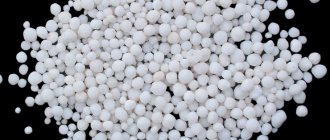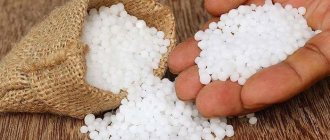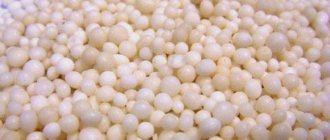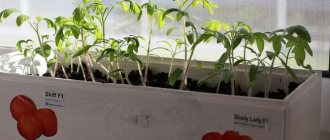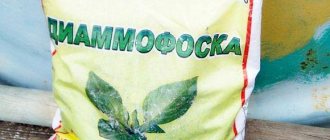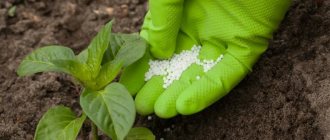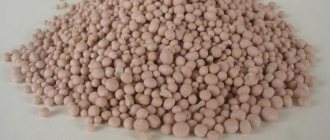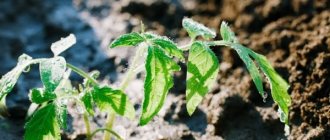Potassium monophosphate: fertilizer characteristics
Monopotassium phosphate is a mineral fertilizer.
It dissolves in water and is absorbed by the soil in a short time, which provides an immediate effect.
Potassium monophosphate - photo
Fruits and vegetables grown with monopotassium phosphate fertilizer are saturated with sugar even during ripening. It will improve the taste and increase the shelf life of the fruit. Nowadays fertilizing is used in gardens and vegetable gardens, as well as for indoor plants.
Indications for use
Based on the above-described properties and characteristics of potassium monophosphate, it is recommended to use it for feeding cultivated plants:
- For seedlings of garden crops in average weather conditions and favorable years. In unfavorable years, when planting in the ground is delayed, it is better to stimulate root formation at the box-pot stage with a limited amount of nutrition with rootstock.
- For more abundant flowering, reduced ovary drop and better fruiting - all garden food crops.
- Ornamental open ground crops - for more abundant and longer flowering.
- For seasonal outdoor flowers: hanging, potted.
- For emergency foliar feeding of outdoor and indoor plants in the presence of signs of acute potassium starvation: browned, “rusted,” wrinkled and curled edges of leaves.
Composition of potassium monophosphate fertilizer
Potassium monophosphate works when used correctly. The composition of the potassium monophosphate fertilizer is simple, it contains potassium (33%) and phosphorus (50-55%). The presence of two components improves yield and vitamin content. The shelf life of the fruit is also extended.
Important!
The formula for potassium monophosphate is designated as follows: KHPO.
Potassium monophosphate is produced as:
- Powder
- Granule
What does potassium monophosphate look like in the form of granules and powder - photo
Description
This fertilizer is ballastless. Made from high-percentage potassium-phosphorus concentrate. Available in 500 gram plastic bags or 25 kg bags. The use of monopotassium phosphate in agronomy is possible in the form of granules or powder of different colors:
- white;
- beige;
- light brown.
It must be borne in mind that if a pronounced yellowness is observed in the color, this indicates the presence of undesirable impurities.
Potassium monophosphate: mechanism of action and properties
The element potassium is involved in the water-salt metabolism of plants. Potassium increases plant immunity to various infectious diseases, improves the taste of fruits and their saturation with sugars. adds density and elasticity to vegetables.
Properties of potassium monophosphate - video
Phosphorus is an important participant in plant photosynthesis; it promotes more active growth of vegetative mass, improvement of the root system, and formation of ovaries.
Important!
Potassium monophosphate has high solubility in water, which allows plants to receive the most necessary nutrients in the shortest possible time.
Once potassium monophosphate is dissolved in water, a lot of phosphoric acid will be supplied to the plants. Moreover, this does not affect the chemical processes in the soil. The component may not absorb phosphorus. It is present in the soil. Potassium interacts with the soil and is absorbed by crops; it does not accumulate in the ground.
Fertilizer analogues
In the absence of monopotassium phosphate, it can be replaced with other mineral fertilizers that have a similar effect on vegetable, garden and ornamental crops.
How can I replace potassium monophosphate?:
- Potassium nitrate is an excellent source of nitrogen and potassium, strengthens the immune system of plants and improves the taste of fruits.
- Superphosphate – contains a combination of phosphorus and nitrogen. Improves the growth of the green part of crops and strengthens the root system.
- Wood ash is a natural fertilizer that contains potassium. Its concentration depends on the type of initial wood raw material.
Potassium monophosphate is a highly effective fertilizer for vegetable, garden and ornamental crops. This feeding has a complex effect. It stimulates plant growth, strengthens the immune system and the root system. Protects against many diseases and increases productivity.
Advantages and disadvantages
Monopotassium phosphate fertilizer has differences from others, such as monocalcium phosphate.
The benefits of fertilizing include:
- Rapid absorption by soil.
- No harmful components for seedlings.
- Protection from cold during frosts.
- High-quality moistening of dry soil.
- Effective also for all indoor flowers.
- Increasing the number of shoots in young crops.
- Compatibility of potassium monophosphate with pesticides.
- Lack of soil oxidation properties.
- Plant protection from powdery mildew.
Brief overview of potassium monophosphate - video
Many plants require additional feeding. The complex effect can significantly improve productivity.
But monopotassium phosphate also has disadvantages:
- Cannot accumulate in soil.
- Not used to prepare plants for winter.
- Weeds feed on this fertilizer.
- Incompatibility of potassium monophosphate with fertilizers containing calcium and magnesium.
- Not suitable for indoor plants that develop slowly.
Now many factories produce fertilizers. But Bui fertilizers are among the most popular. Optimal composition and efficiency make the products in demand.
Advantages and disadvantages
Phosphorus-potassium fertilizing is well accepted and absorbed by all parts of plants, that is, not only by the root system, but also by stems and foliage. It does not include chlorine and is completely safe for nature and humans, unless added randomly and in large quantities.
There are other advantages:
- fertilizing activates the growth of full-fledged side shoots;
- increases immunity to powdery mildew and other pests, as well as diseases;
- improves sensitivity to temperature changes, especially frost, as well as changes in air humidity;
- promotes long and active flowering of ornamental crops and indoor flowers;
- activates root formation in seedlings;
- helps retain moisture in the soil in greenhouses, which is important during the dry season;
- reduces the fall of ovaries, increases their quantity and quality;
- activates the absorption of vitamins and carbohydrates, which has a beneficial effect on the taste of the fruit.
Agricultural technologists and agronomists also talk about the disadvantages of monopotassium phosphate:
- stops the growth of cuttings of roses and other flowers that are cut for bouquets;
- slows down the growth of ornamental plants that themselves develop slowly, for example, succulents, orchids;
- not compatible with potash and magnesium fertilizers;
- suitable only for one-time processing, since the constituent elements are destroyed under the influence of air and sunlight;
- quickly washed out after prolonged rains and active frequent watering, so regular application is required, since plantings react acutely to a lack of potassium;
- activates the growth of not only vegetables, trees, bushes, but also weeds.
After being added to the soil, potassium monophosphate crystals immediately disintegrate; it is better to dissolve them in water. They are not suitable for autumn preparation of soil for wintering. Capricious and demanding of the environment. For their positive effect, humidity should be moderate and temperature not high.
During storage of potassium monophosphate, the granules should not be allowed to get wet so that they do not dissolve and lose their beneficial properties. Experts advise purchasing this fertilizer in small packages intended for single application.
When should you use monopotassium phosphate?
Potassium monophosphate powder and granules can be used as plant nutrition.
This fertilizer is used for:
- Seedlings. During unfavorable weather, the time for planting in open ground is extended. For root formation with limited nutrition, it is advisable to choose root.
- Excellent flowering and reducing the number of fallen ovaries, improving the yield.
- Long-lasting and high-quality flowering.
- Feeding plants with brown leaves.
FERTILIZERS for the garden and vegetable garden!
• Azofoska • Ammofoska • Nitrophoska
Features of the use of superphosphate fertilizers
The product is used for root nutrition or as foliar fertilizer for open and closed soils. Before watering, pre-moisten the soil.
Potassium monophosphate is effective:
- after picking, during transplanting seedlings;
- when feeding decorative plantings during the flowering period, fruit plants - after flowering;
- against powdery mildew (grapes, apples, cucumbers, roses);
- as a component of complex mixtures;
- on medium and small areas with manual processing.
How to use monopotassium phosphate for different crops
First you should familiarize yourself with the rules for using bait. Instructions for using potassium monophosphate fertilizer are indicated on the packaging. It is better to create a solution in small quantities, since its components quickly disintegrate, and after which it will be useless.
There are general rules for diluting potassium monophosphate for seedlings, vegetables, and flowers.
You can prepare a solution based on:
- 10 g of fertilizer is diluted in 10 liters of water - this solution of potassium monophosphate is used for seedlings of various crops;
- 15-20 g per 10 liters of water - this product is used to feed vegetable crops grown in open ground;
- 30 g per 10 liters of water - a solution in this concentration should be used for fruit and berry crops.
Dosage and method of application - photo
According to reviews, the effect of potassium monophosphate is better if foliar sprays are applied to the leaves in the evening. Then the drug does not evaporate for a long period and is able to be absorbed in a short time.
Important!
Potassium monophosphate becomes 30% less effective an hour after creating the solution.
Gardeners highlight another feature of feeding. Wild plants and weeds are highly sensitive to the drug. Therefore, before the procedure, weeding and loosening of the top layer of soil is required.
Potassium monophosphate for seedlings
The use of potassium monophosphate for vegetable and flower seedlings
When creating a solution for irrigation, it is important to maintain the correct concentration. It is created in a ratio of 7-10 g of monophosphate to 10 liters of water. A solution of potassium monophosphate is used for seedlings of flowers and plants.
Potassium monophosphate for strengthening seedlings - video
The first feeding is carried out when the first 2-3 true leaves appear on the seedlings, the second is carried out 2 weeks after picking or planting the seedlings in open ground, the concentration is the same - 7-10 g per 10 liters of water.
Useful article:
How to improve the composition and fertility of the soil in the garden
Tomatoes - feeding with potassium monophosphate
To ensure high-quality feeding of tomatoes, watering with potassium monophosphate should be done no more than 2 times a season. Such actions allow you to get a high-quality harvest. There should be at least 2 weeks between procedures. For this, a 0.15% solution is used. It is advisable to take a quarter of a bucket per bush. 10 liters of solution are used for about 4 adult tomatoes.
Photo of preparation of fertilizing tomatoes with potassium monophosphate
If the year is favorable, the break between waterings will be at least 3 weeks. It is important to consider the pace of plant development. If necessary, between main treatments, foliar spraying is carried out with a solution with a fertilizer concentration not higher than 0.15% of the green part. It is advisable to use a solution with this concentration after heavy rainfall.
Cucumbers - rules for fertilizing potassium and phosphorus
Feeding cucumbers with potassium monophosphate is done by watering them with the solution in the same way as tomatoes. The concentration is the same, but in this case, foliar feeding must be carried out taking into account the type of fruit formation.
Photo of feeding cucumbers with potassium monophosphate using watering solution
During normal fruiting, cucumbers are straight and thick at the base. If they are curved or pear-shaped from the ovary, then this indicates a lack of potassium, so fertilizing in the form of spraying is required. It is preferable to carry out the work before watering. If the cucumbers taste bitter due to a lack of potassium, then it will be too late to perform any procedures.
Potatoes, root vegetables, onions, garlic - fertilizer with potassium monophosphate
Thanks to the use of fertilizers, the harvest will be much better. To do this, spraying is performed. If you water, this will cause an increase in the root system.
Photo of spraying potatoes
The concentration of potassium monophosphate for feeding potatoes, beets, carrots, onions, garlic and other similar vegetables should be 0.1-0.2%. It is advisable to carry out treatment 2 times during the season.
The same rules apply to feeding root crops and bulbous plants.
Interesting article:
Rules for fertilizing strawberries for a good harvest
Berry and fruit trees
To treat trees and shrubs (watering or spraying), a concentrated solution of potassium monophosphate is used: 30 g of the substance is needed for 10 liters of water. Although, according to some instructions for using this product for berry crops, the traditional concentration should be used, 15 g per 10 liters. Be sure to read the instructions and annotations before processing plants!
Photo of spraying a fruit tree
For a bush, the solution consumption is 7-10 liters per square meter. m. Taller trees require 15-20 liters. The use of fertilizing will improve the yield many times over.
Feeding berry bushes and fruit trees with potassium monophosphate is carried out in three stages:
- immediately after flowering;
- 2 weeks after the first;
- in autumn, mid-September.
Useful article:
How to feed raspberries
Potassium monophosphate for flowers
For flowers, fertilizer is used when the buds open. If the year is favorable, the seedlings are watered with a 0.1% solution. The norm is 3-4 liters per square meter. m.
Photo of spraying flowers
If the flowers have 3-4 leaves, then for early flowering they are sprayed with 0.02% potassium monophosphate. Outdoor flowerpots and hanging flowers should be fed, just like ground plantings. Such fertilizers are used for many flowering plants: petunias, tulips, phlox, roses.
Application for grapes
Using one MFC is not enough, and it is not advisable. Because the culture is highly dependent on magnesium. In the second half of their life, the grapes are fed potassium magnesium, which can quickly leach. Therefore, in cool, damp times, preferably in the fall, in September, you can apply a one-time fertilizer, preparing the plant for winter.
Fertilizer can be applied to the grapevine through watering and foliar feeding “on the leaf” in the traditional concentration of 15 g per 10 liters of water.
Chemical composition and operating principle
Potassium monophosphate (KH2PO4) is a complex mineral supplement containing the potassium salt of orthophosphoric acid. To obtain it, phosphoric acid and potassium carbonate, chloride or hydroxide are mixed. Tuk is rich in potassium (28%) and phosphorus (23%). The nutrients contained in this fertilizer are quickly and completely absorbed by vegetation.
Potassium dihydrogen phosphate is characterized by the absence of components harmful to crops. We are talking about chlorine salts, heavy metals, sodium. The use of a solution of this mineral fertilizer does not threaten the planting with burns to the foliage and root system, even if it is more concentrated than the manufacturer recommends.
In its pure form, potassium monophosphate has the appearance of colorless crystals, characterized by good water solubility. Tuk is sold granulated and powdered. It has a beige tint. If the color of the powder or granules is yellowish, there is iron or chlorine in the complementary foods. It's not worth buying.
The potassium-phosphorus substance is sold packaged in bags of 20-15 g, 500 g, 1-2 kg. If it is incorrectly used or stored, it loses its specified properties.
Mineral fertilizer is used to water the planting at the roots. For this purpose, a solution (hydrate) is prepared from powder or granules, following the instructions for the drug. Only distilled water is suitable for dissolving the powder mass.
After watering, nutrients are delivered to all tissues of the green organism. Hydrate does not cause chemical reactions in the soil. The nutrient liquid not absorbed by the plant roots, being in the garden soil, continues to feed the root system.
Feeding cucumbers
Cucumbers are fed by watering with a solution of potassium monophosphate, similar to tomatoes. The concentration of the spraying solution is the same, however, in the case of cucumbers, foliar feeding must be carried out, paying attention to the developing fruits.
If ripened normally, the fruit will be straight and thicker at the base than at the tip. If the cucumbers are curved or pear-shaped from the ovary, this is a sign of potassium deficiency, which means that urgent fertilizing by spraying is necessary.
This type of feeding of ripening cucumbers is a priority over watering treatment, because if the cucumbers begin to taste bitter due to a lack of potassium, then it will be too late to take any measures.
For example, if watering is scheduled to take place in a week, but curvature of the fruit is already observed, it should be postponed, since the interval between the use of potassium monophosphate should be at least 1.5–2 weeks.
Read also Tomato monisto pink reviews photos
Characteristics of the drug
The product has the form of a crystalline powder. It is a valuable drug, a source of phosphorus-potassium composition. Contains the following vital ingredients for tomatoes:
- 50-55% phosphorus;
- 33% potassium.
Monopotassium phosphate fertilizers for tomatoes guarantee a rich harvest with excellent taste. Potassium improves sugar saturation and increases vitamin levels. Tomatoes grow to a considerable size and have an attractive presentation.
The product dissolves well in settled or boiled water. To prepare the working solution, you can use the following forms:
- granules;
- powders from white to light brown.
Has neutral acidity. Does not cause burns or other damage.
The prepared solution is not stored for long. Therefore, the drug is diluted immediately before use.
Spraying root crops
Root crops should be fertilized with potassium monophosphate only by spraying. Feeding by irrigation will in this case lead to an excessive increase in the size of the root system due to a significant reduction in the quantity and commercial qualities of the tubers themselves.
The required concentration of the working solution is 0.02–0.05%; treatment should be carried out twice during the season according to the regulations. The same rules apply to feeding other root crops and edible bulbous plants.
Bushes and trees
Garden trees and shrubs are fertilized with potassium monophosphate, according to the instructions, mainly through watering. Unscheduled fertilizing by spraying is required only in favorable years and after heavy rainfall. Only the green parts are sprayed. It is necessary to ensure that the undersides of the leaves are well processed.
Irrigation treatment is carried out 1.5–2 hours after the soil has been thoroughly moistened.
You can treat trees and shrubs in the morning, provided that the ground is sufficiently moist, excluding rain or fog - such fertilizing will not harm the plants, but the fertilizer will be lost. Mature trees that consistently bear fruit can be treated with a 0.02% solution.
Tomato processing
It is recommended to water no more than twice a season with an interval of two weeks. For treatment, use a 0.15% solution of potassium monophosphate. The average consumption is one quarter of a bucket of solution per bush. In favorable years, the interval between waterings is increased to at least three weeks, based on the rate of plant development.
If required, between main treatments, additional spraying can be done with a solution with a concentration of 0.02% of the green part.
It is recommended to treat plants with a solution of the same concentration after heavy rainfall.
Reviews from gardeners
Oleg, Tula
Flowers and even ovaries can drop due to cold, heat, or overfeeding with nitrogen. Reduce nitrogen to zero, inhibit it with NITROGEN-FREE potassium and phosphorus. As an example, potassium monophosphate.
Source: dacha.wcb.ru
Svetlana, Novosibirsk
We have been using it for feeding for about four years now. The price and quality are good. We no longer use any other drugs.
Source: ok.ru
Nitrogen Compatible
A good response to phosphorus and potassium is observed in plants that have healthy and powerful green mass, which requires nitrogen. Potassium monophosphate can be used together with nitrogen fertilizers, but you should not risk preparing a common mixture.
Potassium monophosphate has high activity, which makes it possible to minimize the gap when using potassium-phosphorus and nitrogen fertilizers to a minimum of 2 to 5 days; the shorter the interval, the wetter the weather. Nitrogen should be introduced after using potassium-phosphorus fertilizers, with the exception of nitrogen-fixing crops such as legumes, clover, and alfalfa.
Potassium monophosphate has its drawbacks, although it is an excellent mineral fertilizer:
- Feeding with it is possible only in dissolved form, since it does not accumulate in the soil and disintegrates extremely quickly. Using solid fertilizer will not harm the plants, but it makes no sense - all the fertilizer will be wasted;
- The fertilizer is not suitable for preparing open ground plantings for winter;
- It is most effective in the summer when the weather is favorable, when it is not very hot and quite humid. In greenhouse conditions, sufficient lighting and ventilation are necessary;
- Another drawback is that potassium monophosphate is as well absorbed by weeds as by cultivated plants. Therefore, its use in the garden or garden should be combined with regular weed control measures;
- Potassium monophosphate should be stored only in a dry room, as it is hygroscopic and may lose its properties at high humidity. In dissolved form, it should be stored away from light and air. You should buy the drug in packages that can be used immediately, and use the finished fertilizer immediately after preparation.
- It is incompatible with magnesium and calcium based fertilizers. This significantly limits its use for some crops;
- Potassium monophosphate causes active formation of side shoots, which limits its use when growing cut flowers. Even when cutting off the racemes/inflorescences, the cutting remains too short for a vase or bouquet. This worsens the presentation and reduces profitability;
- Since monopotassium phosphate is a highly active fertilizer, it is not suitable for “dormant” indoor plants such as cyclamens, abutylenes, dodecatheons, succulents, orchids, azaleas, gloxinias, strepocarpus, and others.
Read also: How to propagate roses by cuttings in water in autumn
Other types of feeding tomato seedlings
Fertilizers are very important for tomato seedlings. First of all, they are added when preparing the soil in which tomato seeds are sown for seedlings. If you purchase a ready-made substrate for vegetable plants, then it already contains all the necessary nutrients for the growth and development of seedlings. But, the amount of soil in the containers is small, so young plants quickly select useful substances during the growth process, and, therefore, it is necessary to replenish the supply of fertilizers during the period of active growth of seedlings.
Other fertilizers
Potassium sulfate: fertilizer, application for tomatoes
To do this, you can use an ammophosphate solution that contains nitrogen. This microelement is necessary for the active growth of the above-ground parts of tomatoes.
Please note: when applying fertilizers to tomato seedlings, you should adhere to certain dosages of the drugs, which are usually indicated in the instructions for their use on the package. After all, an excess of fertilizers can also negatively affect the condition of young plants, as can a severe lack of them, so fertilizers should be used in moderation.
And the appearance of the seedlings will tell about the lack of certain macro and microelements.
If the lower leaves of tomatoes turn yellow, it means the plant does not have enough nitrogen, so most of this element is taken up by the more “promising” upper leaves. If there is a shortage of this element, seedlings may slow down their growth.
If the back side of the foliage takes on a purple tint, this means the plant does not have enough phosphorus. If at the same time the plant continues to grow and develop, then at the seedling stage you can not apply fertilizers containing phosphorus, but do this after transplanting the seedlings to a permanent place.
If seedlings do not have enough potassium, then their root system is poorly developed by the time of transplantation into open ground. In this case, the further development of this vegetable crop will be slow.
A lack of iron is very bad at the initial stage of tomato development, since the development of the tomato’s immunity, and, therefore, their resistance to diseases and pest attacks, depends on its amount. The lack of this element is immediately noticeable - the foliage becomes sharply lighter, and the veins become darker.
A good tomato harvest can only be obtained by providing the plants with comprehensive, balanced nutrition. Tomatoes must receive the nutrition they need - do not neglect monophosphate feeding, otherwise you may end up with tomatoes that are simply unsuitable for food.
5 4 votes
Article rating
